5 Better Alternatives to Excel for Tracking SaaS Tools
Excel struggles to keep pace as every team spins up new SaaS tools each quarter. Rows overflow, formulas break, and renewal dates disappear in hidden tabs before finance even notices the overspend. Trying to track sprawling contracts in a static sheet leaves procurement guessing at usage patterns that could fuel stronger negotiations. It’s time to move on.
An automated SaaS management platform can surface every license and alert you when spending suddenly drifts. Some groups, however, stay with lighter options, tweaking shared spreadsheets or database hybrids and entering everything manually. The best route depends on your app count, the depth of insight you need, and the hours you’re willing to burn on data entry.
This guide lines up five practical alternatives to Excel: purpose-built SaaS management tools, Google Sheets, Notion, Airtable, and ClickUp. Use it to cut software waste before the next renewal cycle sneaks up.
Table of Contents
- SaaS Management Platforms
- Google Sheets
- Notion
- Airtable
- ClickUp
- Conclusion
- Audit your company's SaaS usage today
SaaS Management Platforms
Purpose-built SaaS management tools shove Excel aside as soon as they scan the network for paid and free apps. Within an hour, most platforms comb SSO logs, expense cards, and browser extensions, then roll up a tidy roster that still catches veteran IT admins off guard. Because discovery never stops, the inventory stays fresh and finance and security share the same data.
Once the list is trustworthy, value shifts to the dashboard. License counts, login frequency, and feature usage flow into live widgets; a quick look shows who needs fewer seats and who needs more. AI helpers inside platforms like Zylo compare market pricing and flag savings opportunities before renewals land, while calendar views call out opt-out dates vendors like to hide. The upshot is earlier, calmer decisions rather than last-minute scrambles.
- Audit essentials
- SOC-2 ready export of every contract, bill, and approval trail
- SSO and HRIS connectors that add or remove seats automatically
- Zero spreadsheets, macros, or tab hopping
- Watch-outs
- Setup for connectors and roles usually runs one to three weeks
- Subscriptions average five to ten dollars per employee each month
Teams running more than fifty apps or about 250,000 dollars in annual SaaS spend usually earn the subscription back within one quarter. Lighter stacks can win as well, though fixed fees eat more of the gain. If shadow IT keeps tripping audits or renewals spark frantic Slack threads, automation brings order no spreadsheet can match.
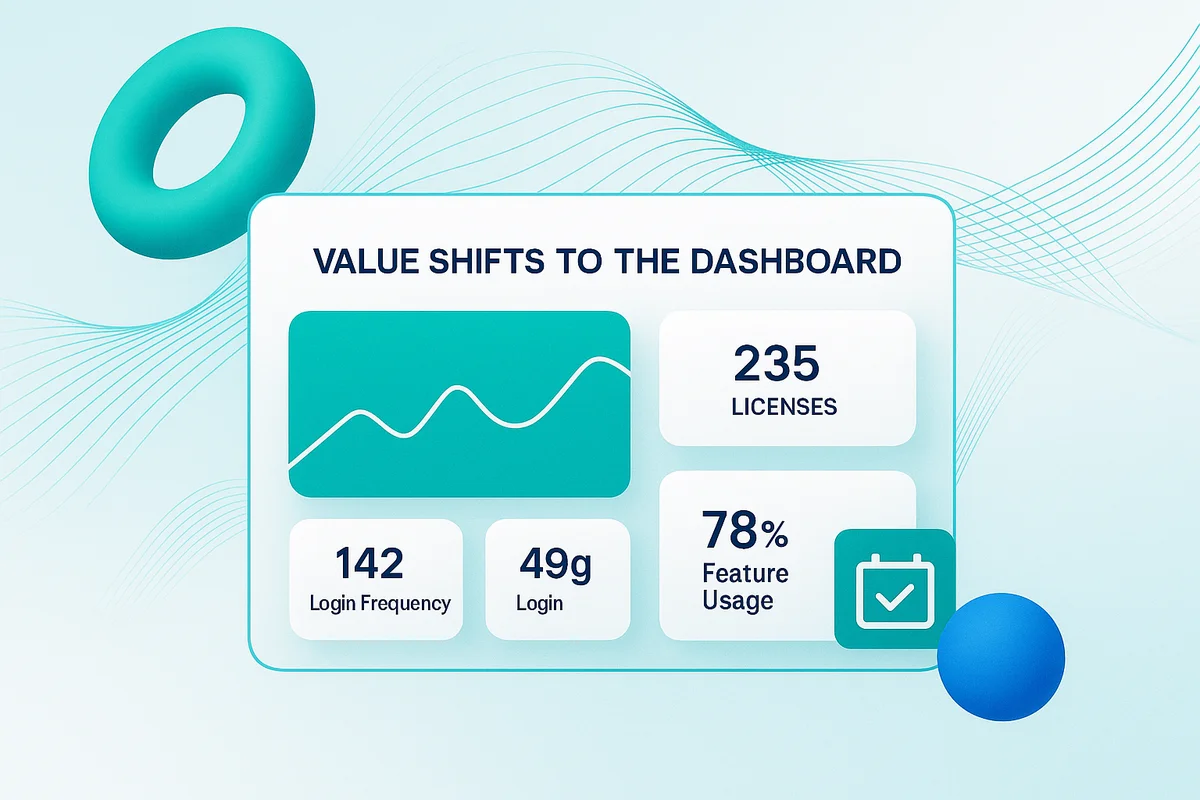
Google Sheets
Google Sheets often acts as a drop-in replacement for desktop spreadsheets without forcing users to install anything. Teams already on Gmail jump in with almost no learning curve and can coedit the same file without cell locks or endless email threads. Version history captures every tweak so finance can reverse an accidental overwrite, while threaded comments keep the running discussion in one place.
Beyond simple sums and averages, Sheets reaches far past basic math. Apps Script automations fire Slack alerts when a renewal date nears, QUERY joins pull spend by department, and 15,000-row pivot tables still load smoothly on a midrange laptop. If you pay for Workspace Enterprise, Connected Sheets plugs straight into BigQuery so your analysis runs on billions of rows without exporting CSVs first.
That flexibility carries a trade-off, and the currency is sweat equity. Every vendor name, seat count, and contract value still relies on a human keeping the sheet fresh, and busy quarters can turn that chore into a graveyard of stale numbers. Rate limits (100 requests every 100 seconds) may choke dashboard refreshes right when leadership asks for an updated savings forecast.
Most companies remain on the free tier bundled with Workspace, yet those same teams hit a wall when they need granular permissions or live data pulls. Before deciding, weigh the upside of instant adoption against the hidden cost of constant data grooming.
Quick snapshot
- No extra Sheets fee if you already license Google Workspace
- Real-time editing, comments, and version history trim duplicate files
- Apps Script and Connected Sheets widen reporting but slam into API quotas
- Manual upkeep invites slip-ups, especially during end-of-quarter audits
- BigQuery links and tighter security require the Enterprise upgrade
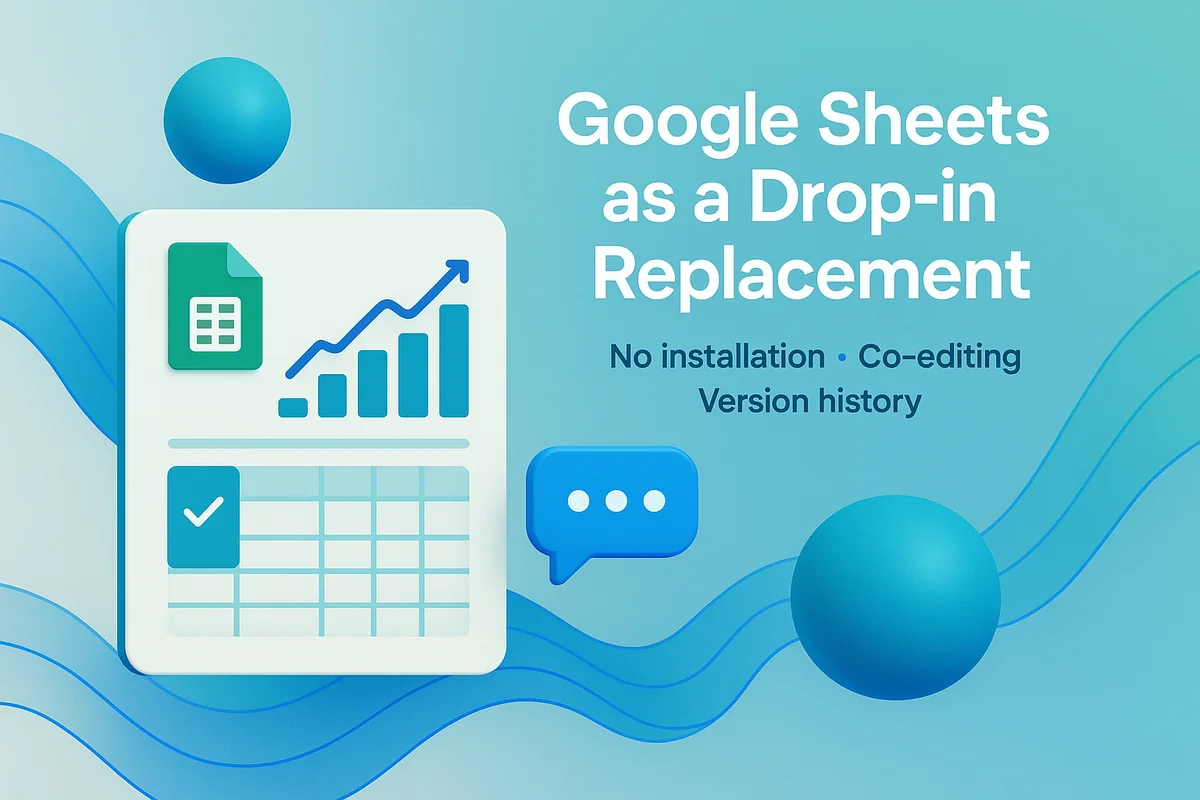
Notion
Notion turns SaaS tracking into a living wiki, not another brittle spreadsheet. Instead of parking contract data in lonely tabs, finance and IT can pin renewal playbooks, onboarding checklists, and vendor chat threads beside each record. That context saves the usual ping-pong of emails when someone asks, “Who owns DocuSign and what did we pay last year?”
The real power sits inside its database blocks, which act like spreadsheet tabs that talk to each other. Teams link a Vendor table to a Contract table, then roll up costs by department with one select field. Views can flip from a Kanban of onboarding status to a calendar of renewal deadlines in seconds. A few benefits pop out:
- One page shows spend, playbooks, and team notes side by side
- Inline relations let a single price tweak ripple across every dashboard
- Comment threads keep audit chatter out of Slack
- The API works with Zapier to spin up renewal tasks automatically
Still, the shine fades once the table tops a few thousand rows. Filters crawl, mobile editing stutters, and the API caps at three requests per second, which hampers real-time dashboards. Large uploads such as security reviews balloon workspace size and push databases toward the 5 GB limit sooner than expected. Notion also lacks a native link to financial systems, so someone has to paste invoice totals or route them in through a paid connector such as Make.
Notion’s Business plan, about fifteen dollars per user each month, unlocks SSO, audit logs, and granular permissions. That price sits below most dedicated SaaS-management apps yet above the zero dollars many teams anticipate after starting on the personal tier. If your company already relies on Notion for product specs or OKRs, adding a SaaS asset database can work (just budget time for manual data hygiene every quarter).
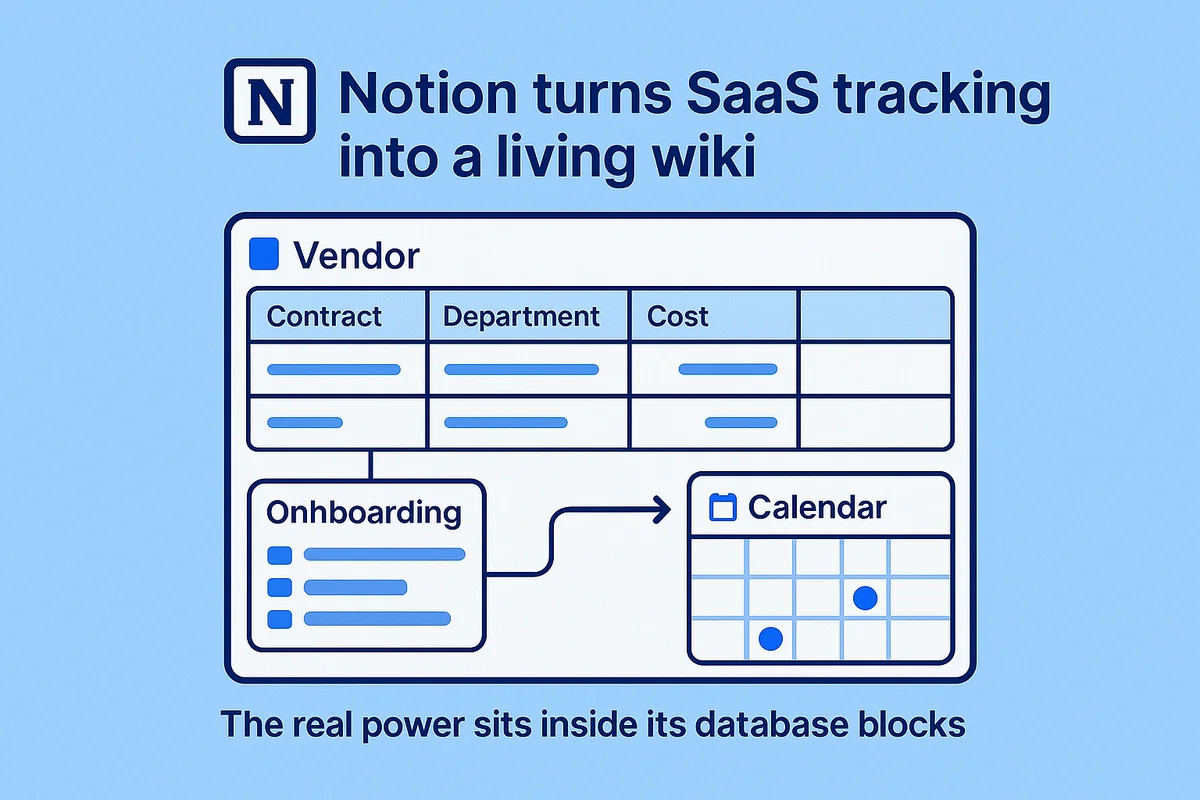
Airtable
Teams that want structure yet still move at spreadsheet speed often end up on Airtable. The grid looks familiar but every row acts like its own record, close to a lightweight CRM. A buyer can link a Vendor base to a Contracts base and filter for next-quarter renewals in two clicks. Designers then flip that same data into colorful widgets leaders read, shutting down the copy-paste shuffle between sheets and slides.
For SaaS tracking, the platform stands out in a few specific ways:
- Ready-made Software Inventory template already includes cost center, owner, license count, and renewal date.
- Linked records automatically roll up spend by department and vendor without wrestling with JOIN formulas.
- Automations send email and Slack pings to the account owner 30 days before auto-renew, preventing surprise fees.
- Dashboards compare annual spend to forecast so finance no longer chases an updated slide.
Still, Airtable will not collect usage data for you alone. Someone has to pull invoices or export login reports from Okta, then map them to the right record. Free and Plus tiers top out at 5,000 records, and the 100-run automation limit disappears fast when vendors push monthly reminders and quarter-end true-ups.
Many midsize IT or finance teams see real savings once SaaS spend passes 250,000 dollars and a single owner watches data hygiene. At that point, the Pro plan at roughly 20 dollars per user each month costs less than one missed cancellation window. If the stack grows past 150 tools, you will probably graduate to software built specifically for SaaS management that pulls usage, cost, and security data on its own.
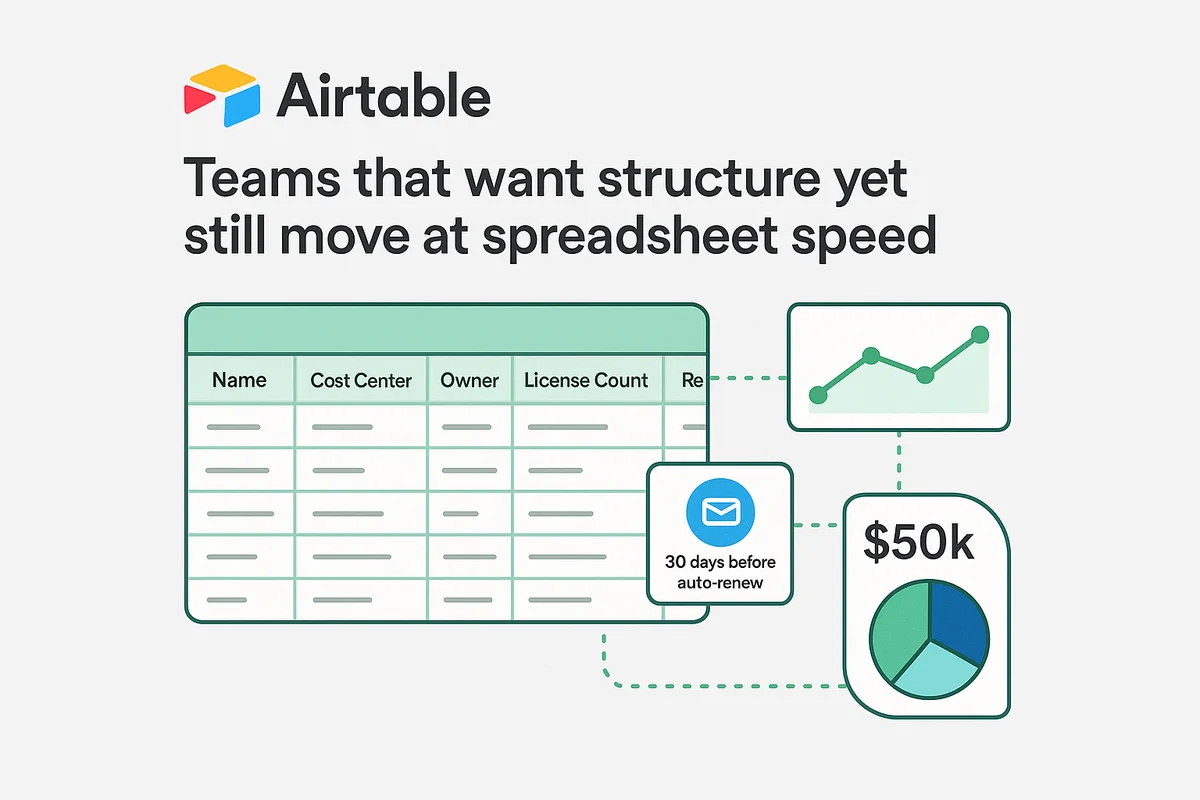
ClickUp
ClickUp makes SaaS oversight feel like just another sprint, not a side spreadsheet project. Teams already mapping roadmaps, help-desk tickets, and rollouts inside ClickUp can spin up a “SaaS Portfolio” space in minutes, pulling cost, owner, and renewal data into the same agile rhythm that drives everything else.
Custom fields handle most of the data wrangling for SaaS tracking. One column records monthly spend, another flags auto-renew windows, and a third links to the latest invoice in Google Drive. Because these records live inside a task, assignees, comments, and reminders appear automatically. Switch to Board view for a Kanban of upcoming negotiations, then jump to Gantt to spot renewal clusters that could squeeze cash flow in Q4. A single dashboard rolls it all up by department, exposing duplicate seats before the invoice lands.
Automations are where ClickUp starts to feel like a dedicated SaaS manager. Mark a task “Renewal in 90 days” and ClickUp pings the budget owner on Slack, opens a checklist for legal review, and sets a due date for price benchmarking. Users on the Business tier, priced at $12 per user per month, can fire off up to 10,000 of these flows before they hit the ceiling. Finance teams also rely on granular permissions, locking rate cards so only approvers can edit numbers.
- Pros:
- Shared workspace puts SaaS tasks right beside project work
- Dashboards surface spend trends without the weekly CSV export
- 10,000 automations on the Business plan slash manual follow-up
- Goals module ties savings targets to actual dollars
- Cons:
- API pull for license counts is thin, mostly Jira, Slack, and a handful of others
- Usage numbers still need manual entry, so data can go stale
- Large attachments chew through storage and nudge teams toward pricier tiers
Many teams already run development sprints or procurement workflows in ClickUp, so adding SaaS tracking to that same environment tightens accountability and keeps everyone on one screen, even when a few figures still arrive by copy-paste.
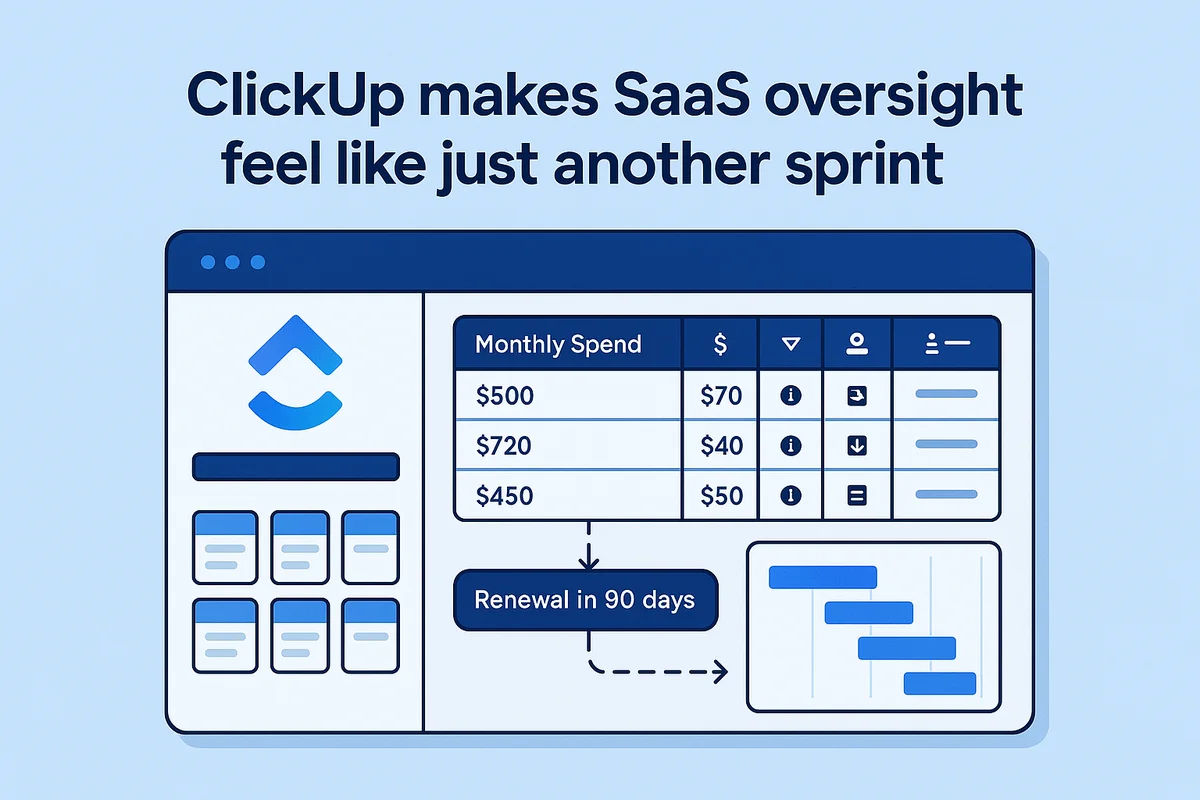
Conclusion
Choosing the right tool to replace Excel hinges on factors like automation, collaboration, and scale. Sheets, Notion, Airtable, and ClickUp provide familiar views and basic automations, yet teams still chase invoices, update licenses, and monitor renewal dates; dedicated SaaS management platforms line up every app, highlight idle seats, and trigger cost alerts without extra copy-paste work.
Match your budget, tolerance for manual tasks, and app count to each option, and the answer becomes obvious. For most teams that need quick, lasting cuts to software waste, a dedicated SaaS management platform wins.
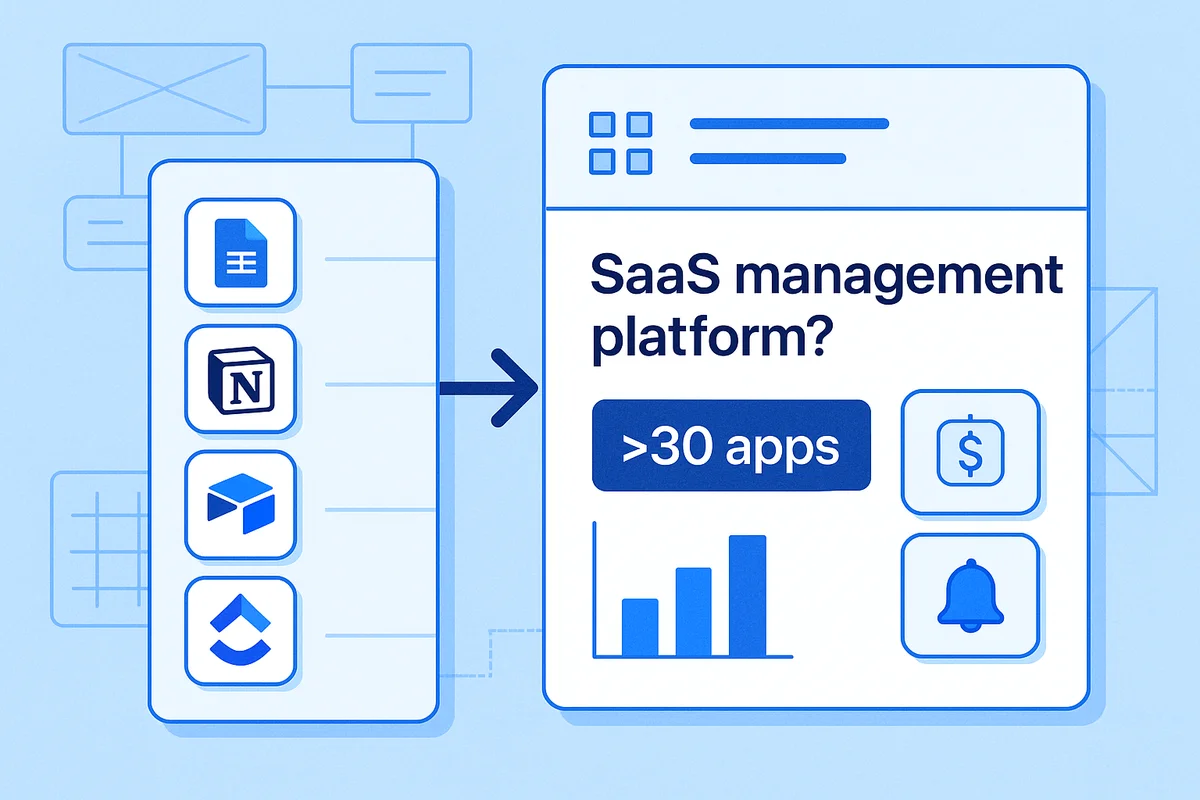
Audit your company’s SaaS usage today
If you’re interested in learning more about SaaS Management, let us know. Torii’s SaaS Management Platform can help you:
- Find hidden apps: Use AI to scan your entire company for unauthorized apps. Happens in real-time and is constantly running in the background.
- Cut costs: Save money by removing unused licenses and duplicate tools.
- Implement IT automation: Automate your IT tasks to save time and reduce errors - like offboarding and onboarding automation.
- Get contract renewal alerts: Ensure you don’t miss important contract renewals.
Torii is the industry’s first all-in-one SaaS Management Platform, providing a single source of truth across Finance, IT, and Security.
Learn more by visiting Torii.
Frequently Asked Questions
Excel struggles with scalability, leading to broken formulas, hidden renewal dates, and lack of real-time insights, often resulting in overspending.
A SaaS management platform automates contract tracking, providing live data on licenses, expenses, and alerts for renewals, significantly reducing manual workload.
Alternatives include Google Sheets, Notion, Airtable, ClickUp, and purpose-built SaaS management tools, each offering unique features for efficient contract tracking.
Google Sheets is user-friendly, allows real-time collaboration, and supports automation via Apps Script, making it a strong alternative to Excel.
Notion combines contract tracking with a collaborative wiki-like experience, allowing integration of vendor information, comments, and task management in one space.
Airtable provides a structured format that links records across bases, facilitating easier tracking of contracts and spending without complex formulas.
ClickUp integrates SaaS management into project workflows, allowing users to track costs, renewal dates, and automate notifications directly within their task management system.

